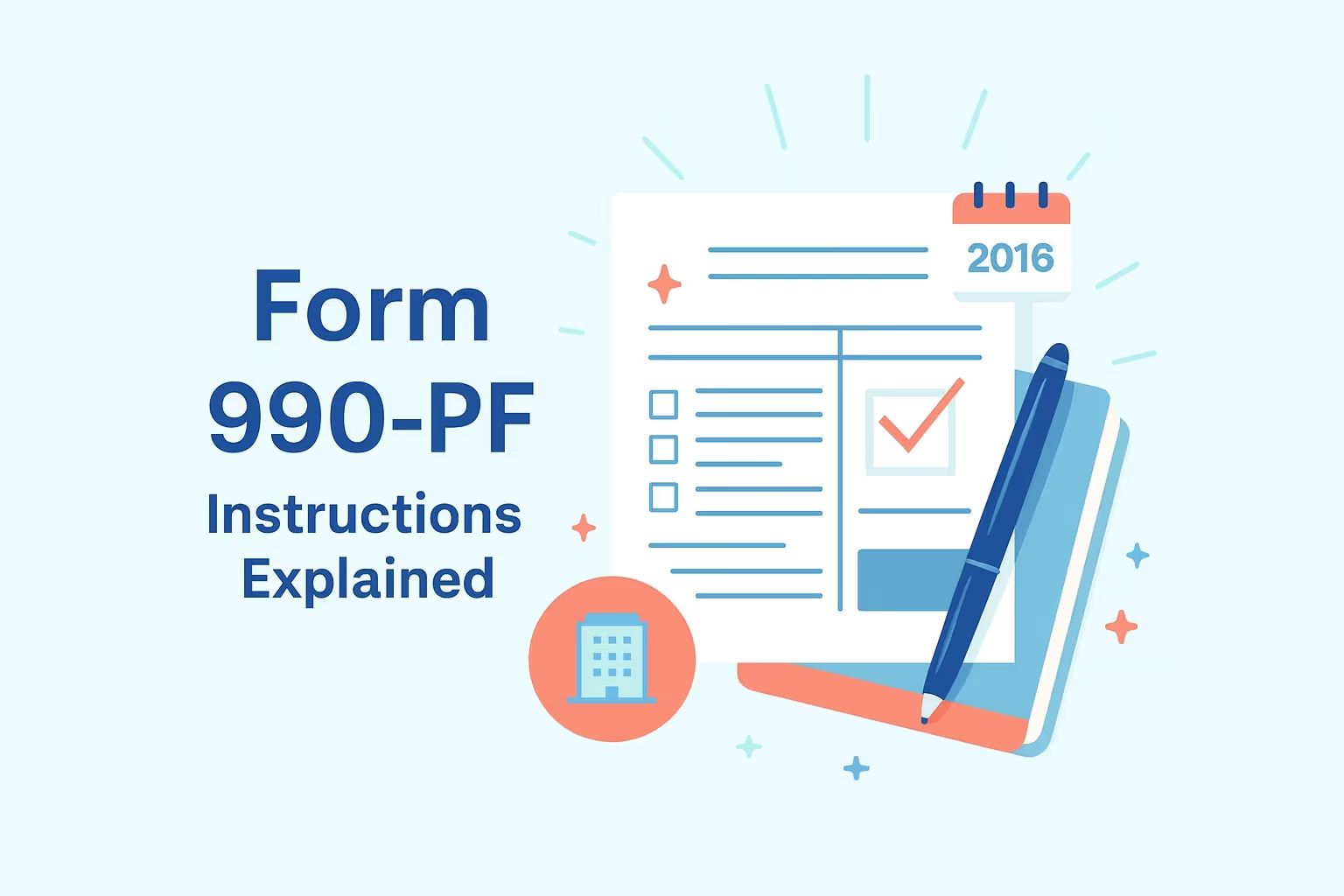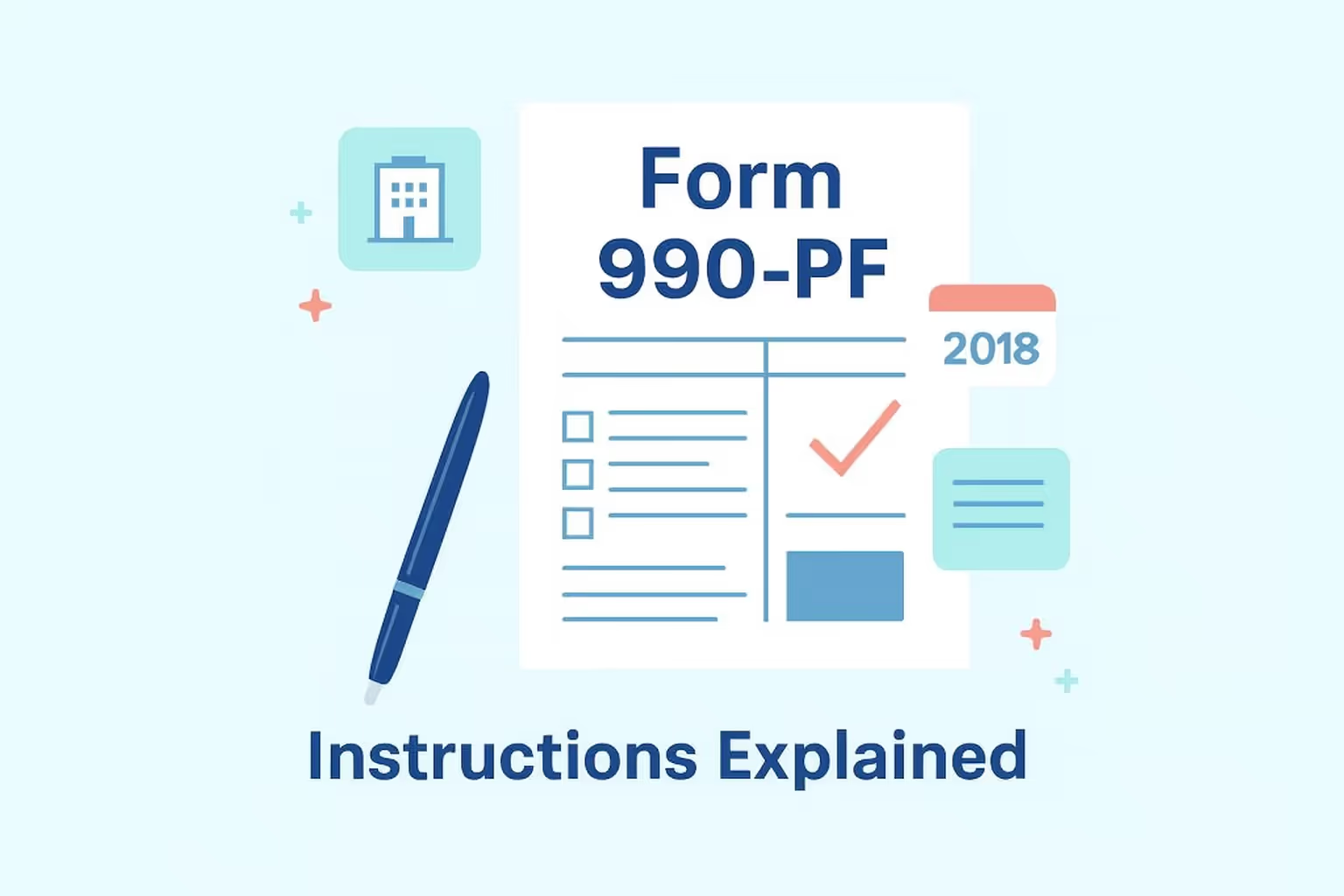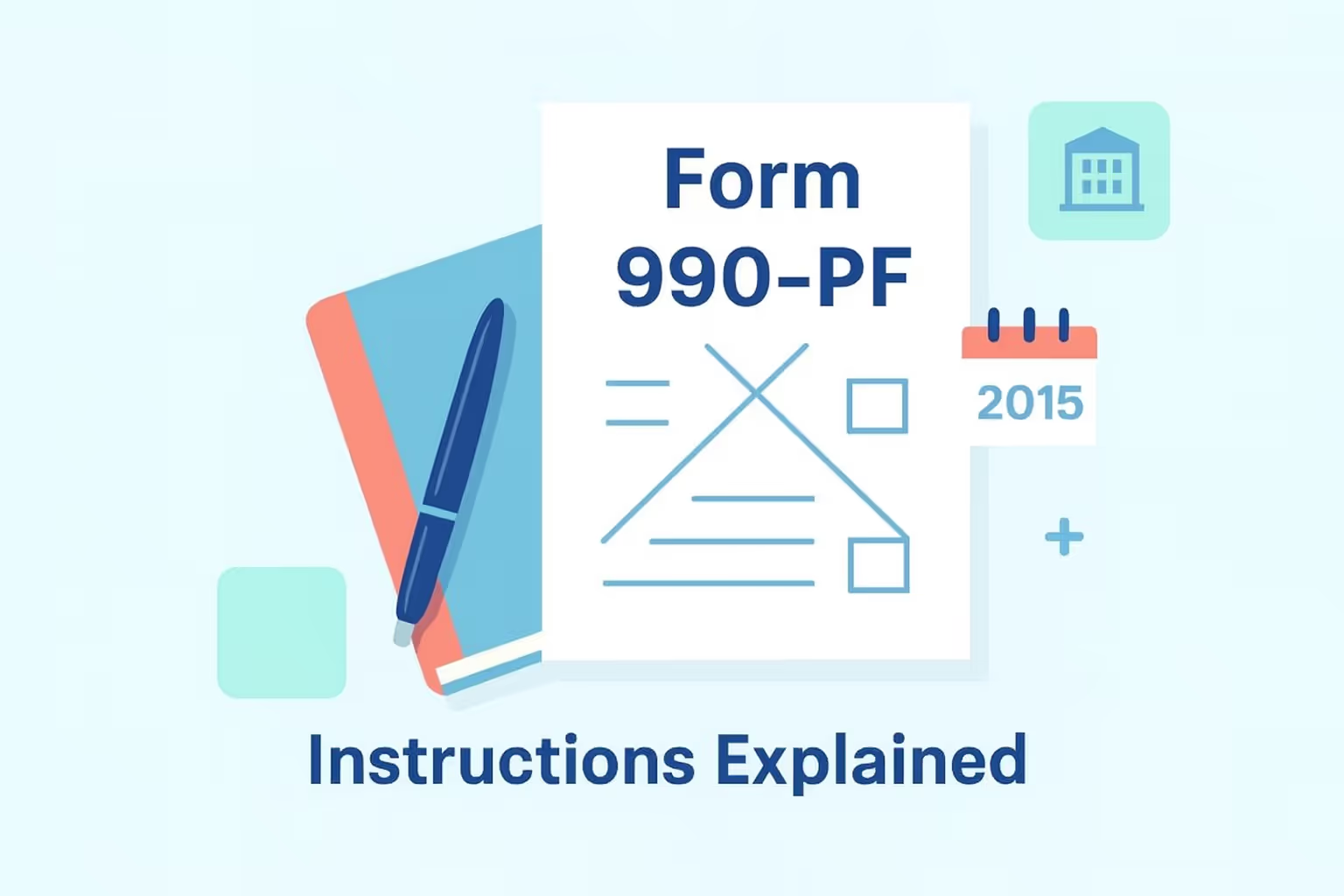Instrucciones del formulario 990-PF 2016: Guía de fundaciones privadas

La presentación del formulario 990-PF es un paso obligatorio para las fundaciones privadas que deben cumplir con el Servicio de Impuestos Internos y el Código de Impuestos Internos. Este formulario sirve como una declaración de impuestos sobre la renta diseñada específicamente para fundaciones privadas exentas y sujetas a impuestos, lo que garantiza que cada organización mantenga la transparencia al presentar su información financiera. Completar el formulario correctamente mantiene la condición de exentas de impuestos y permite a las organizaciones sin fines de lucro demostrar su responsabilidad ante el público.
Para el año tributario 2016, las organizaciones debían presentar su declaración de fundación privada antes del 15 de mayo de 2017, a menos que operaran en un año fiscal diferente. El proceso de presentación requiere detalles sobre los ingresos netos por inversiones, las distribuciones caritativas y los ingresos brutos de la fundación. Las fundaciones también deben declarar las actividades generadoras de ingresos, como los intereses de las cuentas de ahorro y las inversiones relacionadas con los programas. Dado que la declaración del formulario 990-PF se convierte en un registro público, la precisión es esencial para evitar el rechazo y garantizar el cumplimiento.
Las fundaciones operativas privadas y otras organizaciones exentas de impuestos también utilizan esta presentación para explicar sus propósitos exentos y dirigir sus actividades caritativas. Para este informe anual se requiere información complementaria, actividades financieras y distribuciones que califiquen. Con una preparación cuidadosa, las organizaciones pueden cumplir con sus obligaciones sin demoras ni errores en la presentación de informes.
Comprensión de las fundaciones privadas y quién debe presentar una solicitud
Las fundaciones privadas operan bajo reglas específicas que definen su estado de exención de impuestos y determinan sus obligaciones de presentación de informes. Estas organizaciones se diferencian de las organizaciones benéficas públicas y otras organizaciones sin fines de lucro porque sus fondos generalmente provienen de fuentes limitadas, como familias, individuos o corporaciones.
El Servicio de Impuestos Internos exige que varias categorías de fundaciones y fideicomisos presenten anualmente una declaración en el formulario 990-PF, garantizando la rendición de cuentas por los ingresos netos por inversiones, las distribuciones caritativas y las actividades financieras.
Fundaciones privadas exentas
Una fundación privada exenta califica como una organización exenta de impuestos según la sección 501 (c) (3) del Código de Rentas Internas. Estas organizaciones deben presentar un informe anual, detallando sus fines caritativos, los saldos de fondos y la información financiera, mediante el formulario 990-PF. Siguen siendo elegibles para recibir un trato favorable solo cuando cumplen con los requisitos de distribución y divulgan con precisión las actividades generadoras de ingresos.
Fundaciones privadas imponibles
Las fundaciones privadas sujetas a impuestos son entidades que perdieron la exención pero siguen obligadas a presentar la declaración bajo el mismo marco de presentación de informes. Estas organizaciones están obligadas a revelar sus ingresos brutos, ingresos netos y obligaciones basadas en impuestos especiales. La presentación de la declaración de una fundación privada garantiza que el Servicio de Impuestos Internos continúe monitoreando sus actividades financieras y de impuestos sobre la renta a pesar del cambio de estatus.
Los fideicomisos caritativos no exentos se tratan como fundaciones privadas
Algunos fideicomisos caritativos no exentos se tratan como fundaciones privadas para fines de cumplimiento. No están clasificados como organizaciones sin fines de lucro tradicionales, pero aun así deben presentar la declaración del formulario 990-PF. Estos fideicomisos deben divulgar las inversiones relacionadas con el programa, los intereses de las cuentas de ahorro y otras actividades financieras para que el Servicio de Impuestos Internos mantenga un registro coherente de la administración de los recursos caritativos.
Fundaciones operativas privadas
Las fundaciones operativas privadas dirigen sus recursos hacia fines caritativos a través de programas y servicios. Con frecuencia administran museos, centros de investigación o bibliotecas, y dedican la mayor parte de sus ingresos a dirigir actividades caritativas. Si bien presentan el mismo formulario que otras fundaciones, sus informes hacen hincapié en las distribuciones que reúnen los requisitos y en la alineación con los fines exentos, más que en la concesión de subvenciones.
Estado pendiente o en reclamación
Las organizaciones que reclaman el estatus de fundación privada mientras esperan su reconocimiento también deben presentar el formulario 990-PF. Deben seguir los mismos estándares que las fundaciones privadas exentas reconocidas para garantizar la transparencia durante el proceso de revisión. El Organizaciones benéficas y sin fines de lucro del IRS La página explica cómo estas organizaciones divulgan sus actividades financieras y distribuciones caritativas a pesar de su estado pendiente.
Obligación general de presentación
La obligación de presentación se aplica a las fundaciones privadas exentas, las fundaciones privadas sujetas a impuestos, las fundaciones operativas privadas y los fideicomisos caritativos no exentos. Al exigir informes consistentes sobre los ingresos netos por inversiones, los saldos de los fondos y los fines filantrópicos, el Servicio de Impuestos Internos refuerza la confianza del público en las organizaciones sin fines de lucro. Este amplio requisito garantiza que las fundaciones privadas sigan rindiendo cuentas en el cumplimiento de su misión caritativa.
Requisitos de presentación, plazos y reglas del año tributario calendario
Las fundaciones privadas deben cumplir con los plazos de presentación anual y las normas federales de presentación de informes para mantener su estado de exención de impuestos según el Código de Impuestos Internos. El Servicio de Impuestos Internos exige que todas las fundaciones privadas exentas, fundaciones privadas sujetas a impuestos y fideicomisos caritativos no exentos que se consideren fundaciones presenten el formulario 990-PF cada año. La presentación garantiza que la información financiera, los saldos de los fondos y las distribuciones filantrópicas permanezcan transparentes y estén disponibles para su revisión pública.
Quién debe presentar el formulario 990-PF
Las organizaciones sujetas a este requisito incluyen:
- Las fundaciones privadas exentas reúnen los requisitos de la sección 501 (c) (3) del Código de Impuestos Internos y continúan operando con fines caritativos.
- Las fundaciones privadas sujetas a impuestos perdieron su exención, pero aún deben presentar una declaración anual de una fundación privada.
- Los fideicomisos caritativos no exentos se tratan como fundaciones privadas, que siguen obligadas a divulgar las actividades generadoras de ingresos y las inversiones relacionadas con los programas.
- Las entidades que reclamen el estatus de fundación privada mientras esperan el reconocimiento deben presentar una solicitud para demostrar su responsabilidad ante el Servicio de Impuestos Internos.
Fechas límite de presentación y reglas del año tributario calendario
Las fundaciones que operan en un año tributario calendario deben presentar su declaración antes del decimoquinto día del quinto mes siguiente al final del año. Para el año tributario 2016, la fecha límite fue el 15 de mayo de 2017. Si la fecha límite coincide con un fin de semana o un feriado federal, se extiende hasta el siguiente día hábil. Las personas que presentan declaraciones durante el año fiscal aplican la misma regla, con plazos ajustados a su ciclo de presentación de informes.
Extensiones y devoluciones modificadas
Las organizaciones que no puedan cumplir con el plazo de presentación pueden solicitar una prórroga automática de seis meses presentando el formulario 8868. La prórroga se aplica únicamente a la fecha límite de presentación y no a los pagos basados en impuestos especiales ni a las obligaciones tributarias estimadas. Se requieren declaraciones modificadas cuando una organización identifica errores u omisiones en las actividades financieras o en las distribuciones caritativas.
El Instrucciones para el formulario 990-PF del IRS para 2016 describa estos requisitos en detalle, asegurándose de que las organizaciones comprendan sus obligaciones en cuanto a la presentación de informes puntuales y precisos. El cumplimiento evita demoras y posibles medidas coercitivas por parte del Servicio de Impuestos Internos, lo que contribuye a la transparencia de las organizaciones sin fines de lucro que dependen de la confianza del público.
Al hacer cumplir estos plazos y requisitos, el Servicio de Impuestos Internos garantiza que las fundaciones privadas divulguen sus actividades financieras con prontitud y de manera consistente. Prestar especial atención a las fechas de vencimiento, las prórrogas y las declaraciones modificadas permite a las organizaciones mantener su condición de exentas de impuestos y demostrar su responsabilidad en la administración de los recursos caritativos.
Lista de verificación previa a la presentación para organizaciones
Prepararse para presentar el formulario 990-PF requiere una organización cuidadosa y atención a los detalles. Las fundaciones privadas y los fideicomisos caritativos no exentos deben recopilar registros, confirmar su estado de exención de impuestos y reunir la información financiera necesaria para una divulgación precisa. Una lista de verificación estructurada garantiza el cumplimiento de las normas del Servicio de Impuestos Internos y evita demoras en la presentación de la declaración de una fundación privada.
1. Recopile información financiera
Recopile todos los estados de cuenta bancarios, informes de inversiones y recibos relacionados con fines benéficos. Incluya documentación sobre las actividades generadoras de ingresos, las inversiones relacionadas con los programas y los intereses de las cuentas de ahorro. Los registros exhaustivos proporcionan una base precisa para declarar los ingresos netos por inversiones, las ganancias de capital y otras actividades financieras.
2. Confirme el estado de fundación privada
Verifique si la organización califica como fundación privada exenta, fundación privada sujeta a impuestos o fideicomiso caritativo no exento tratado como fundación. Las entidades que esperan ser reconocidas pero que reclaman la condición de fundación privada también deben prepararse para presentar la declaración. El establecimiento de la clasificación correcta garantiza que los informes se ajusten al Código de Impuestos Internos.
3. Recopile datos de declaraciones de impuestos anteriores
Revise la declaración de impuestos sobre la renta del año anterior para garantizar la coherencia en la presentación de los ingresos brutos, los saldos de los fondos y los ingresos no distribuidos. La información anterior ayuda a calcular el rendimiento mínimo de la inversión y las obligaciones tributarias estimadas. La alineación de los datos actuales con las presentaciones anteriores refuerza la precisión de la divulgación financiera.
4. Prepare los cronogramas de distribuciones e inversiones
Enumere todas las distribuciones caritativas, las distribuciones que califican y las actividades caritativas directas realizadas durante el año. Documente las inversiones relacionadas con el programa, incluidas las fechas de adquisición, el costo y el valor actual. Organizar esta información antes de archivarla garantiza una información precisa tanto de las actividades financieras como de los fines exentos.
5. Organice la información complementaria
Muchos estados exigen anexos de respaldo o divulgaciones adicionales además de la declaración federal del formulario 990-PF. Prepare notas sobre los honorarios legales, los gastos profesionales y la información complementaria sobre los administradores de fundaciones y los empleados altamente remunerados. La coordinación estatal evita la duplicación de informes y garantiza el cumplimiento en todas las jurisdicciones.
Seguir esta lista de verificación ayuda a las fundaciones a cumplir con sus obligaciones de presentación de manera eficiente y precisa. La preparación organizada garantiza que el Servicio de Impuestos Internos reciba información precisa sobre los fines caritativos, los ingresos netos y las obligaciones basadas en los impuestos especiales. El mantenimiento constante de los registros refuerza la confianza del público en las organizaciones sin fines de lucro que administran los recursos de fundaciones privadas.
Completar el formulario 990-PF paso a paso
Completar el formulario 990-PF requiere precisión y atención a los detalles. Cada parte de la declaración solicita información financiera específica, divulgaciones sobre fines caritativos y datos sobre las operaciones de la organización. Un proceso estructurado paso a paso garantiza que las fundaciones privadas y las organizaciones relacionadas cumplan con todos los requisitos de presentación de informes y mantengan el cumplimiento con el Servicio de Impuestos Internos.
Paso 1: Complete la sección de encabezados
Comience con el nombre legal, la dirección postal y el número de identificación del empleador de la fundación. Identifique el método contable utilizado (efectivo o de devengo) y marque el tipo de declaración (inicial o final). Para las organizaciones que siguen un año tributario natural, introduzca las fechas comprendidas entre el 1 de enero y el 31 de diciembre. Los declarantes del año fiscal, por otro lado, deben indicar el período de informe que eligieron.
Paso 2: Reporte los ingresos brutos y los aspectos financieros básicos
Introduzca los ingresos brutos de la fundación, incluidas las contribuciones, los ingresos por inversiones y otras actividades generadoras de ingresos. Indique los ingresos netos de las inversiones, los pagos de intereses de las cuentas de ahorro y las ganancias de capital derivadas de la venta de valores o activos. Las fundaciones también deben hacer un seguimiento de los ingresos no distribuidos para calcular el rendimiento mínimo de la inversión.
Paso 3: Complete la Parte I: Ingresos y gastos
Indique los ingresos en la columna (a), los ingresos netos por inversiones en la columna (b) y los ingresos netos ajustados en la columna (c) cuando corresponda. Indique en la columna (d) las distribuciones caritativas, los gastos del programa y los costos administrativos directamente relacionados con los fines exentos. Cada inscripción debe basarse en registros financieros precisos para demostrar la transparencia en las actividades económicas de la fundación.
Paso 4: Complete la Parte II: Balances
Proporcione los saldos iniciales y finales de año para los saldos de activos, pasivos y fondos. Los activos deben incluir cuentas de ahorro, valores, bienes inmuebles y otras formas de propiedad, mientras que los pasivos abarcan las cuentas por pagar, los préstamos y las hipotecas. Se deben incluir los valores justos de mercado cuando los activos superen los 5000 dólares en cualquier momento del año tributario.
Paso 5: Complete las partes IV a VI: Cálculos de impuestos
- Parte IV: La fundación debe registrar las ganancias y pérdidas de capital de las transacciones de inversión.
- Parte V: La fundación debe determinar la elegibilidad para la tasa impositiva reducida del uno por ciento en función de las distribuciones que califiquen.
- Parte VI: La fundación debe calcular el impuesto especial adeudado sobre los ingresos netos por inversiones, asegurándose de que el monto coincida con los pagos de impuestos estimados realizados durante el año.
Paso 6: Divulgar a los administradores de la fundación y la compensación
Identifique a todos los gerentes, funcionarios, directores y empleados altamente remunerados de la fundación. Proporcione todos los detalles de la compensación, los beneficios y los reembolsos pagados durante el año. Esta información garantiza el cumplimiento de las normas de divulgación que rigen a las entidades exentas de las organizaciones y mejora la rendición de cuentas ante el Código de Impuestos Internos.
Paso 7: Adjunte los horarios requeridos y la información complementaria
Adjunte cronogramas de contribuciones, subvenciones, inversiones relacionadas con el programa y cualquier gasto que supere los montos límite. La información complementaria también debe detallar los honorarios legales, los servicios de contabilidad y otros costos profesionales. Cada archivo adjunto debe incluir el nombre de la fundación y el número de identificación del empleador para evitar confusiones si el Servicio de Impuestos Internos solicita una aclaración.
Paso 8: Revise la precisión y el envío de los archivos electrónicos
Revisa cada sección para confirmar la coherencia entre los saldos de los fondos, las actividades financieras y los fines caritativos. Se recomienda la presentación electrónica para reducir los errores y acelerar la confirmación de la aceptación. Si el IRS rechaza la declaración presentada electrónicamente, la fundación debe corregir los errores de inmediato y volver a enviar la declaración dentro del plazo requerido.
Completar la declaración del formulario 990-PF con precisión respalda el cumplimiento, protege la exención de impuestos y demuestra la responsabilidad ante el público. Un enfoque metódico que abarque los ingresos brutos, los balances, las obligaciones basadas en los impuestos especiales y la información complementaria proporciona un registro claro de las operaciones de una fundación. Con una revisión y presentación cuidadosas, las organizaciones cumplen con sus obligaciones y, al mismo tiempo, fortalecen la confianza del público en su misión caritativa.
Presentación de informes sobre las actividades financieras y la gobernanza
Las fundaciones privadas deben divulgar tanto sus actividades financieras como la información de gobierno en su declaración del formulario 990-PF. La presentación de informes transparentes garantiza el cumplimiento del Código de Impuestos Internos y confirma que los fines exentos se llevan a cabo de manera efectiva y eficiente. Estas divulgaciones también fomentan la confianza pública al demostrar la responsabilidad en la administración de los recursos.
- Actividades financieras
Las fundaciones deben declarar los ingresos netos de inversión, las ganancias de capital y las actividades generadoras de ingresos que contribuyen a los saldos de los fondos. Esto incluye las ganancias de valores, cuentas de ahorro e inversiones relacionadas con programas. La fundación demuestra el cumplimiento de los requisitos basados en los impuestos especiales al proporcionar los ingresos brutos y documentar las distribuciones caritativas. - Propósitos y distribuciones caritativas
La declaración debe incluir detalles de las distribuciones que califican y las actividades caritativas directas. Las fundaciones operativas privadas declaran los gastos del programa, mientras que otras fundaciones declaran las subvenciones y contribuciones realizadas. Esta información demuestra el cumplimiento del estándar de rentabilidad mínima de la inversión y demuestra el uso responsable de los recursos caritativos. - Gobernanza y supervisión
Las organizaciones deben incluir a todos los gerentes, funcionarios y empleados altamente remunerados de la fundación en sus archivos. La divulgación incluye las funciones, la compensación y las relaciones que pueden afectar la presentación de informes financieros o para fines exentos. La transparencia en la gobernanza demuestra la responsabilidad y protege la condición de fundación privada de la organización. - Divulgación pública
La declaración del formulario 990-PF se convierte en un documento público, lo que significa que la información financiera y los datos de gobierno están disponibles para su inspección. Esto refuerza la confianza en las organizaciones sin fines de lucro y garantiza el cumplimiento de las obligaciones de presentación de informes. La precisión tanto en las actividades económicas como en los detalles de gobierno protege la reputación de la fundación y su condición de exenta de impuestos.
Al estructurar los informes financieros y de gobierno de esta manera, las fundaciones privadas mantienen la rendición de cuentas al tiempo que refuerzan la confianza pública. La divulgación precisa y exhaustiva respalda el cumplimiento y destaca el compromiso de la organización con fines benéficos.
Reglas de distribución y propósitos exentos
Las fundaciones privadas deben seguir reglas de distribución estrictas para mantener su estado de exención de impuestos. Estas reglas garantizan que los recursos caritativos se utilicen para distribuciones y actividades que reúnan los requisitos y estén alineadas con fines exentos en virtud del Código de Impuestos Internos. El cumplimiento adecuado de estas obligaciones permite a las fundaciones demostrar su responsabilidad y mantener la confianza del público.
Distribuciones que reúnen los requisitos
- Distribuciones caritativas: Las fundaciones deben asegurarse de que los pagos realizados para subvenciones, becas u otros fines filantrópicos cumplan con los requisitos de distribución anual.
- Inversiones relacionadas con el programa: Las fundaciones pueden calificar las inversiones como relacionadas con un programa cuando apoyan fines exentos, como viviendas asequibles o investigación, y otras metas caritativas.
- Actividades caritativas directas: Las fundaciones operativas cumplen con los requisitos de distribución cuando incluyen servicios programáticos, exposiciones o programas educativos.
- Prórrogas: Las fundaciones pueden transferir el exceso de distribuciones caritativas realizadas en años anteriores para cumplir con las obligaciones actuales.
Requisito mínimo de distribución
- Base de cálculo: Cada fundación debe distribuir al menos el 5% del valor justo de mercado promedio de sus activos no caritativos cada año.
- Ingresos no distribuidos: Cualquier déficit debe corregirse al año siguiente para evitar las consecuencias derivadas de los impuestos especiales.
- Tiempo de distribución: Las fundaciones deben asegurarse de que las subvenciones y los gastos se paguen o se comprometan irrevocablemente dentro del año tributario calendario o período de informe del año fiscal.
- Documentación: Las fundaciones deben mantener registros adecuados, incluidos los acuerdos de subvención y los recibos, para respaldar cada distribución que califique.
Propósitos exentos
- Actividades educativas: Las fundaciones pueden clasificar los fondos para escuelas, bibliotecas o programas académicos como gastos con fines caritativos.
- Investigación científica: Las fundaciones cumplen con propósitos exentos cuando brindan apoyo a proyectos científicos que sirven al bien público.
- Actividades religiosas: Las fundaciones pueden contar las subvenciones a las organizaciones religiosas que cumplen con los requisitos de las organizaciones sin fines de lucro para calcular los totales de distribución.
- Programas de beneficios públicos: Las fundaciones pueden tratar las actividades que promueven el bienestar social, el alivio de las personas que viven en la pobreza o el avance de la salud como propósitos exentos.
El cumplimiento de las normas de distribución garantiza que las fundaciones privadas asignen sus recursos de manera responsable y se alineen con el Código de Impuestos Internos. Las organizaciones protegen su condición de fundación privada documentando las distribuciones que reúnen los requisitos y alineando las actividades con los fines exentos. Esta transparencia respalda el cumplimiento del Servicio de Impuestos Internos y fomenta la confianza en las organizaciones sin fines de lucro que administran los recursos caritativos.
Obligaciones basadas en impuestos e impuestos especiales
Las fundaciones privadas deben cumplir con obligaciones tributarias específicas para cumplir con el Código de Rentas Internas. Los impuestos especiales se aplican a los ingresos netos por inversiones y también es posible que se requieran pagos de impuestos estimados. Estas reglas garantizan que las fundaciones privadas exentas y sujetas a impuestos cumplan con sus obligaciones tributarias especiales sin dejar de cumplir con sus fines caritativos.
El impuesto especial estándar sobre los ingresos netos por inversiones es del 2%, aunque las fundaciones que cumplan con los requisitos de distribución pueden calificar para una tasa reducida del 1%. Los cálculos deben incluir los ingresos de las cuentas de ahorro, los valores y otras actividades generadoras de ingresos. Cuando los ingresos superan los niveles esperados, es posible que las fundaciones también deban presentar pagos de impuestos estimados a lo largo del año.
Requisitos clave de impuestos especiales
- Aplicación de la tasa impositiva: Las fundaciones deben pagar un impuesto especial del 2% sobre los ingresos netos de inversión, a menos que reúnan los requisitos para una tasa del 1%.
- Distribuciones que reúnen los requisitos: Las fundaciones pueden reducir su obligación de impuestos especiales cuando cumplen con las normas mínimas de distribución caritativa.
- Pagos de impuestos estimados: Las fundaciones deben hacer pagos de impuestos estimados si esperan adeudar 500 dólares o más en impuestos especiales durante el año.
- Plazo de pago: Las fundaciones deben realizar pagos trimestrales en mayo, junio, septiembre y diciembre cuando sigan un año tributario calendario.
- Métodos de pago: Las fundaciones pueden optar por pagar a través del Sistema Electrónico de Pago de Impuestos Federales o mediante retiro directo al presentar la declaración electrónicamente.
Las obligaciones de impuestos especiales sirven para regular la forma en que las fundaciones privadas administran sus actividades financieras y, al mismo tiempo, mantienen su estado de exención de impuestos. El cumplimiento de estos requisitos mediante pagos puntuales e informes precisos protege a la fundación de las multas por incumplimiento del IRS. Una planificación cuidadosa garantiza que las organizaciones cumplan tanto con las normas de distribución como con las obligaciones basadas en los impuestos especiales, lo que refuerza su responsabilidad ante el Servicio de Impuestos Internos y ante el público.
PF: Devolución de fundaciones privadas y divulgación pública
Las fundaciones privadas deben presentar una declaración del PF, que divulga información financiera, prácticas de gobierno y distribuciones caritativas. Esta presentación pasa a formar parte del registro público, lo que refuerza la rendición de cuentas mediante la presentación de informes abiertos. El Servicio de Impuestos Internos exige a las organizaciones que divulguen cierta información públicamente y, al mismo tiempo, protejan los datos confidenciales, como los números de seguro social.
Los detalles que aparecen a continuación comparan la información divulgada públicamente con la información confidencial. Esto ayuda a las organizaciones a comprender sus responsabilidades y a garantizar el cumplimiento, a la vez que cumple con las expectativas de las organizaciones exentas de impuestos.
Declaración del formulario 990-PF
- Disponible públicamente: La declaración completa, incluidos los detalles de los ingresos, las actividades financieras y las distribuciones caritativas.
- Confidencial: No se aplica.
Ingresos brutos e ingresos netos de inversión de la Fundación
- Disponible públicamente: Divulgación requerida para demostrar la responsabilidad financiera.
- Confidencial: Ninguna.
Nombres de los gerentes de la fundación y de los empleados altamente remunerados
- Disponible públicamente: La información sobre funciones y compensaciones está abierta a la inspección pública.
- Confidencial: Los identificadores personales, como los números de seguro social, permanecen privados.
Propósitos caritativos y distribuciones calificadas
- Disponible públicamente: Detalles de los propósitos exentos, las subvenciones otorgadas y las actividades caritativas directas.
- Confidencial: Ninguna.
Horarios e información complementaria
- Disponible públicamente: La mayoría de los horarios y notas de apoyo deben estar accesibles.
- Confidencial: Detalles del colaborador en Programa B permanecen privados en la mayoría de los casos.
La divulgación pública de la declaración del PF fortalece la confianza en las organizaciones sin fines de lucro y garantiza el cumplimiento del Código de Impuestos Internos. Al brindar transparencia sobre la información financiera, los fines caritativos y los detalles de la gobernanza, las fundaciones privadas demuestran una administración responsable. La presentación de informes precisos respalda tanto el cumplimiento con el Servicio de Impuestos Internos como la preservación de la exención de impuestos.
Preguntas frecuentes
¿Quién debe presentar una declaración del formulario 990-PF?
Toda fundación privada debe presentar una declaración del formulario 990-PF, independientemente de si se trata de una fundación privada exenta, una fundación privada sujeta a impuestos o un fideicomiso caritativo no exento tratado como fundación. Las organizaciones que reclamen la condición de fundación privada mientras esperan ser reconocidas también deben presentar declaraciones de impuestos. Esta declaración anual revela los ingresos netos por inversiones, los saldos de los fondos y las distribuciones caritativas, lo que garantiza la rendición de cuentas ante el Servicio de Impuestos Internos y el cumplimiento del Código de Impuestos Internos.
¿Cuándo vence el formulario 990-PF para un año tributario calendario?
Las fundaciones privadas que sigan un año tributario calendario deben presentar su declaración del Formulario 990-PF antes del día 15 del quinto mes después del final del año, generalmente el 15 de mayo. Si la fecha límite cae en fin de semana o en un feriado legal, se extiende hasta el siguiente día hábil. La presentación a tiempo garantiza la transparencia en las actividades financieras y ayuda a las organizaciones a proteger su condición de exentas de impuestos, al tiempo que cumplen con sus responsabilidades de presentación de informes ante el Servicio de Impuestos Internos.
¿Qué información debe incluirse en los balances?
Los balances de la declaración del formulario 990-PF deben incluir los saldos de los fondos al principio y al final del año, así como los valores de los activos y pasivos. Los activos pueden consistir en cuentas de ahorro, valores o bienes inmuebles, mientras que los pasivos suelen incluir préstamos o cuentas por pagar. Si los activos superaron los 5000$ en cualquier momento del año, es obligatorio informar con precisión sobre los valores justos de mercado. Estas divulgaciones demuestran cómo la fundación gestiona sus actividades financieras y refuerzan la confianza pública en su rendición de cuentas.
¿Cómo se denuncian las distribuciones caritativas?
Las distribuciones caritativas se declaran como parte de las distribuciones que reúnen los requisitos de una fundación para confirmar el cumplimiento de los fines exentos. Estas incluyen subvenciones, becas, inversiones relacionadas con programas o actividades caritativas directas, como la gestión de un museo o una biblioteca. Se deben adjuntar registros detallados a la declaración para demostrar que los fondos se utilizaron con fines caritativos. La presentación de informes adecuada garantiza que las organizaciones cumplan con el requisito mínimo de rentabilidad de la inversión y mantengan su condición de fundación privada exentas de impuestos.
¿Qué son las obligaciones basadas en los impuestos especiales?
Las obligaciones basadas en impuestos especiales se aplican a los ingresos netos de inversión de las fundaciones privadas. Por lo general, se aplica un impuesto especial del 2%; sin embargo, algunas organizaciones pueden optar a una tasa reducida del 1% si cumplen con los requisitos de distribución específicos. Los ingresos de valores, los intereses de las cuentas de ahorro y las ganancias de capital deben incluirse en este cálculo. El cumplimiento de las obligaciones en materia de impuestos especiales garantiza el cumplimiento continuo con el Servicio de Impuestos Internos y, al mismo tiempo, salvaguarda la posición de la fundación como organización exenta de impuestos.
¿Puede una organización presentar una declaración enmendada?
Sí, una organización puede presentar una declaración enmendada si descubre un error en su presentación original. Las declaraciones modificadas pueden corregir problemas con la información financiera, las distribuciones caritativas o los balances. La presentación de una declaración enmendada demuestra transparencia y garantiza la presentación de informes precisos al Servicio de Impuestos Internos. Al corregir los errores con prontitud, las fundaciones mantienen la responsabilidad y siguen cumpliendo con sus obligaciones en virtud del Código de Impuestos Internos, preservando así su condición de exentas de impuestos y la confianza pública.
¿Cómo se aplica la divulgación pública a las fundaciones privadas?
La declaración del PF de las fundaciones privadas pasa a ser un registro público y exige la divulgación de los ingresos brutos, los ingresos netos por inversiones, los balances y los fines caritativos de la fundación. Si bien la información sobre los contribuyentes que figura en el Anexo B generalmente se oculta, la mayoría de los demás detalles deben estar disponibles para su inspección pública. La divulgación pública de las actividades financieras y los detalles de gobierno refuerza la confianza en las organizaciones sin fines de lucro. La presentación de informes precisos ayuda a proteger la exención de impuestos de una fundación y demuestra que administra sus recursos de manera responsable con fines caritativos.



























